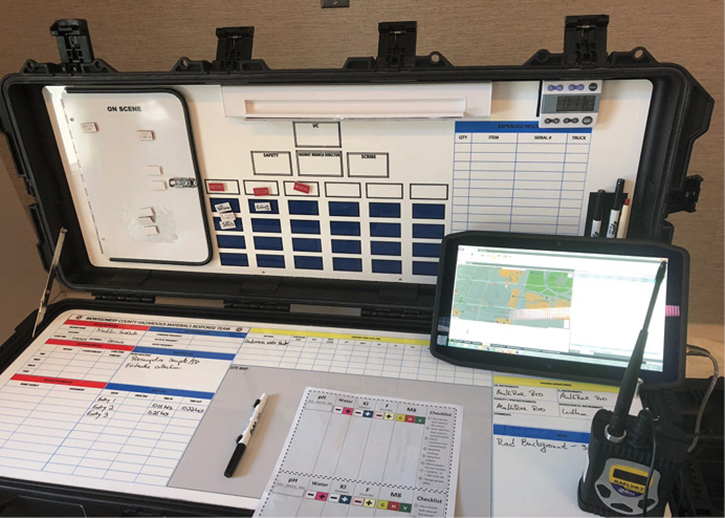
Montgomery County, Pennsylvania, borders Philadelphia, Bucks, Chester, and Delaware counties in the southeastern part of the state and is 487 square miles with a population of 826,000. It is also home to one of the largest shopping malls in America as well as Valley Forge National Park. Although there are several tourist attractions in the county, it also contains more than 500 SARA Title III reporting facilities. These facilities are required to report their chemical inventories annually because of the specific hazardous materials and quantities kept on site. In late 2017, a hazardous materials incident at one of these facilities stretched local resources to the extent of their capabilities.
Montgomery County is comprised of 62 municipalities and is protected by 92 fire companies, 20 emergency medical services (EMS) companies, 50 police departments, the Pennsylvania State Police, and the Montgomery County Hazardous Materials Response Team (MCHMRT).
Implementing a ToxMedic Program in Your Department
The MCHMRT falls within the Division of Emergency Management of the Montgomery County Department of Public Safety. This team is comprised of a full-time chief and 30 part-time members. All members are required to be certified as hazmat technicians and attend a minimum of 30 hours of annual training.

(1) The command board custom designed by the Montgomery County (PA) Hazardous Materials Response Team to better track member accountability throughout an incident. (Photos courtesy of author.)
Because of their dedication and commitment to the MCHMRT, these volunteer members will often take vacation time from their full-time employment to attend advanced training from across the country to improve themselves and the MCHMRT. In 2018, MCHMRT members participated in nearly 2,000 staff hours of training and exercises. Because of the county’s size, the MCHMRT operates out of two stations. Each station is assigned an assistant chief and two battalion chiefs.
Until recently, the MCHMRT levels of response were as follows:
- Level 3
- HazMat officer response.
- Level 2
- Hazmat station response.
- Closest decontamination support company.
- Two ambulances for medical monitoring (preassigned).
- Two ambulances for firefighter rehab (preassigned).
- Level 1
- Both hazmat stations.
- Closest decontamination support company.
- Two ambulances for medical monitoring (preassigned).
- Two ambulances for firefighter rehab (preassigned).
- Field Comm 3 (mobile command post).
Anhydrous Ammonia
The product involved in the following incident was anhydrous ammonia, which has been used as a commercial refrigerant since 1850 because it is cost effective and energy efficient. Anhydrous ammonia is a commercial refrigerant, but it also happens to be a toxic inhalation hazard and is flammable in high concentrations, especially in confined or enclosed atmospheres, posing a significant threat when leaking. When used as a commercial refrigerant, anhydrous ammonia is similar to how antifreeze is used to absorb the heat from a vehicle’s motor. It is stored as pressurized liquid and then piped out throughout a building, where it absorbs heat from the building and converts the liquid to a vapor. Once this phase change is completed, the product is sent into a compressor, where it is converted back to a liquid and then returned into the pressurized storage vessel.
Following are some of the chemical and physical properties of ammonia:
- Immediately dangerous to life or health (IDLH): 300 parts per million (ppm)
- Vapor density: 0.6.
- Vapor pressure: 7,500 millimeters (mm) of mercury (Hg) at 25°C.
- Lower explosive limit: 15 percent.
- Upper explosive limit: 25 percent.
- Odor threshold: 0.4 ppm.
- Colorless gas under atmospheric conditions.
- Strong pungent odor.
The Incident
At 1012 hours on a Sunday morning in late 2017, the Perseverance Volunteer Fire Company of Souderton, Pennsylvania, was dispatched to a meat packing facility in its first-due area for an anhydrous ammonia leak inside the building. On arrival, the local fire company met with facility personnel and were advised by the facility’s safety manager that there was an active leak inside the engine room and the readings were above the facility’s operating threshold (300 ppm).
First-arriving hazmat officers conducted a thorough size-up and concurred that the MCHMRT’s response needed to be upgraded. Initial information was that an employee was inside the anhydrous ammonia storage room shutting two valves on an ammonia line; the employee shut down the downstream valve first. As he was shutting the second valve, he noticed the ammonia leak. In speaking with the employee, it was thought that the piping leak was between two valves with approximately 40 feet of pipe between them. Hazmat officers also inquired if the building’s ventilation system was on and working properly. The officers were assured that the ventilation system was activated.
Based on the initial risk evaluation, the initial entry team selected chemical vapor protective clothing to investigate the source of the leak and, if possible, isolate the leak. The thought process was to isolate the leak, allow the product remaining in the pipe to leak out, ventilate the building, and turn it back over to the facility. Once inside, the entry team realized it needed to remove the pipe insulation to determine the exact location of the leak. Once the insulation was removed, the source of the leak was determined to be a faulty welded joint on the tank side of the isolation valve, meaning there was no way to isolate the 22,000-pound tank from the leak source. Air monitoring indicated that the liquid leak was producing a concentration of 15,000 ppm in the area of the leak.
Prior to exiting the building, the initial entry team members attempted to slow the leak by placing a wet sheet around the source of the leak, thereby creating an ice block. However, this tactic proved ineffective.
Because of the high vapor pressure of ammonia, dry decontamination was selected. This was performed by setting up two positive-pressure fans to help vaporize the product off the member’s PPE as he exited the hot zone. Once the entry team members went through decon, postentry medical monitoring, and rehab, they reported to the incident command post (ICP) to debrief on their observations.
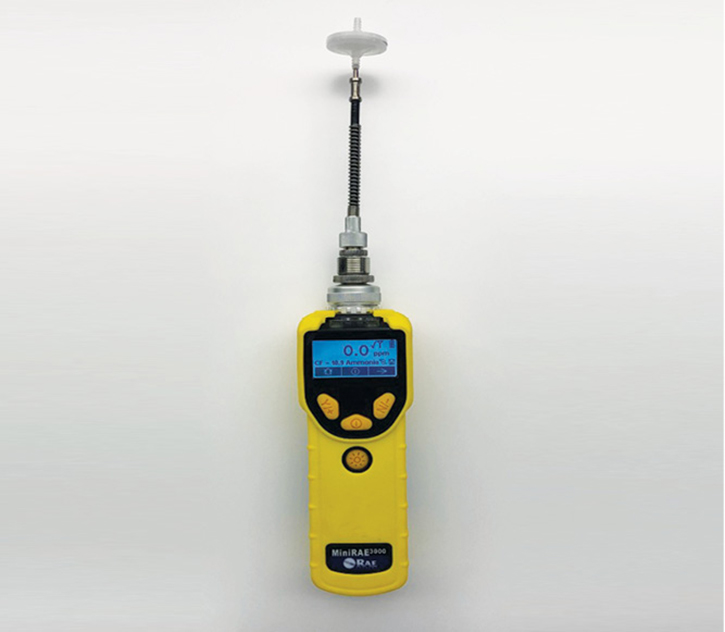
(2) This stand-alone photoionization detector was used at this incident. It allows the user to set the measurement gas to the material being metered. It will also conduct the correction factor automatically, providing the user a true reading in parts per million.

(3) Two technicians enter dry decon (left) while Hazmat Assistant Chief DiPaolo escorts more technicians to the hot zone (right). In the background is the recovery vessel where the product was transferred (center).
Leadership from the local fire company, the MCHMRT, and the facility established unified command. There was a consensus that the only way to mitigate the leak was to offload the leaking storage vessel into a recovery vessel. To accomplish this goal, MCHMRT personnel would be tasked with retrieving electrical connections, activating the power supply for the recovery vessel, isolating the rest of the piping system from the leaking vessel, and then making the related connections from the leaking storage vessel to the recovery vessel.
The second entry team was tasked with isolating the rest of the plant from the leaking storage vessel by locating and shutting 14 valves found throughout the engine room and making two hose connections to the recovery vessel. Once this process was started, it was determined that this task would be much more difficult than originally thought because of inaccurate systems plans, valves located in difficult-to-access areas, and poor valve labeling that created challenges in reading while wearing self-contained breathing apparatus (SCBA) and chemical vapor protective clothing.
The second entry began at 1608 hours and rotated multiple members through to keep track of which valves were shut and which remained open while minimizing the learning curve on the system. Entry team leaders maintained radio contact with the hazmat group supervisor, who kept track of which valves were shut on the system plans at the ICP. The hazmat group supervisor also worked with facility personnel to talk entry team members through locating the remaining valves.
Isolating the rest of the facility from the storage tank was not completed until 2146 hours—more than five hours after the start of the second entry efforts. If the plant was not isolated from the leaking storage vessel, the remaining product in the system would have backflowed into the leaking storage vessel as it was unloaded. This would have led to the recovery vessel filling up prior to completely unloading the leaking storage vessel, leaving no other options on where to transfer the product.
To ensure that all system valves were located and properly shut, a contractor, in chemical vapor protective clothing, entered with MCHMRT members. This contractor had previous experience on this specific system and located the remaining valves that entry team members could not find.
These extended entry operations were taxing on all entry personnel, some of whom made three and four entries. As a result, leadership decided to bring in the Bucks County Hazardous Materials Response Team (BCHMRT) to provide additional staffing. On the BCHMRT’s arrival, its leadership was briefed of the situation and members were sent to medical for preentry evaluation. The BCHMRT made multiple entries in chemical vapor protective clothing to verify all valves were isolated and holding tight while checking the level of remaining product in the leaking storage vessel throughout the unloading process.
The offload process continued throughout the night until 0715 hours the next day. The visible anhydrous ammonia leak had been isolated, and concentrations inside the room were well within the allowable threshold for the incident to be turned over to the facility and its contractors, which occurred at 0800 hours.
Lessons Learned
Interagency collaboration. This was the largest takeaway from this incident. Prior to this incident, I always thought it was cliché to say, “It’s better to meet prior to the event than meet during an emergency.” Following this response, this statement could not be more on point. In southeast Pennsylvania, the leadership of the five county hazardous materials response teams meet on a regular basis to discuss ongoing projects, equipment purchases, training schedules, and joint training efforts. We speak frequently, and this leads to knowing each other and our corresponding training and experiences. The relationships developed prior to the event allowed the second-due hazmat team to hit the ground running for the second operational period. If you don’t know who your second-due is, determine who it is and meet and train regularly. If you have not practiced with your second-due, don’t hesitate. Start now, and make it a regular part of your training plan.
Know your accountability system. Following this incident, we took a hard look at our accountability system and determined that it was insufficient for this operation. Although entry team members were rotated based on their SCBA air level, keeping track of which valves were isolated; which valves still needed to be located; and the status of entry members inside the building, going through decon, and completing medical evaluations was challenging.
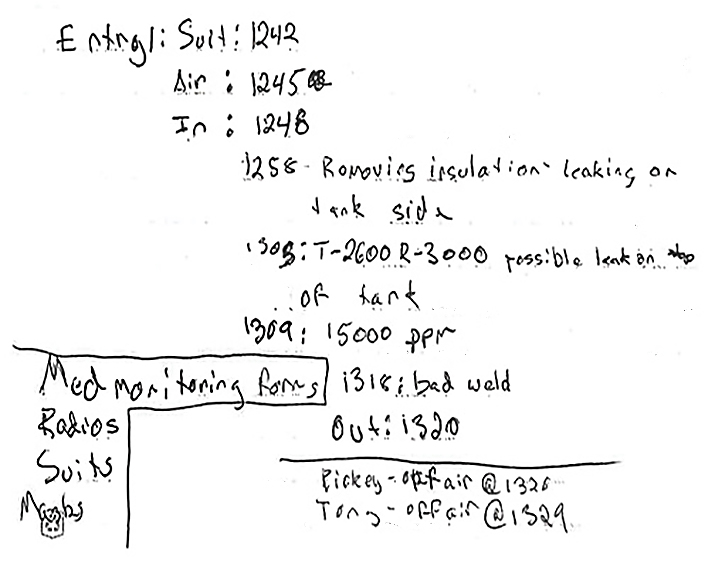
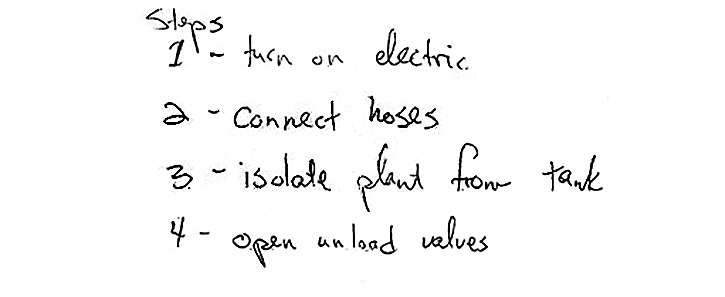
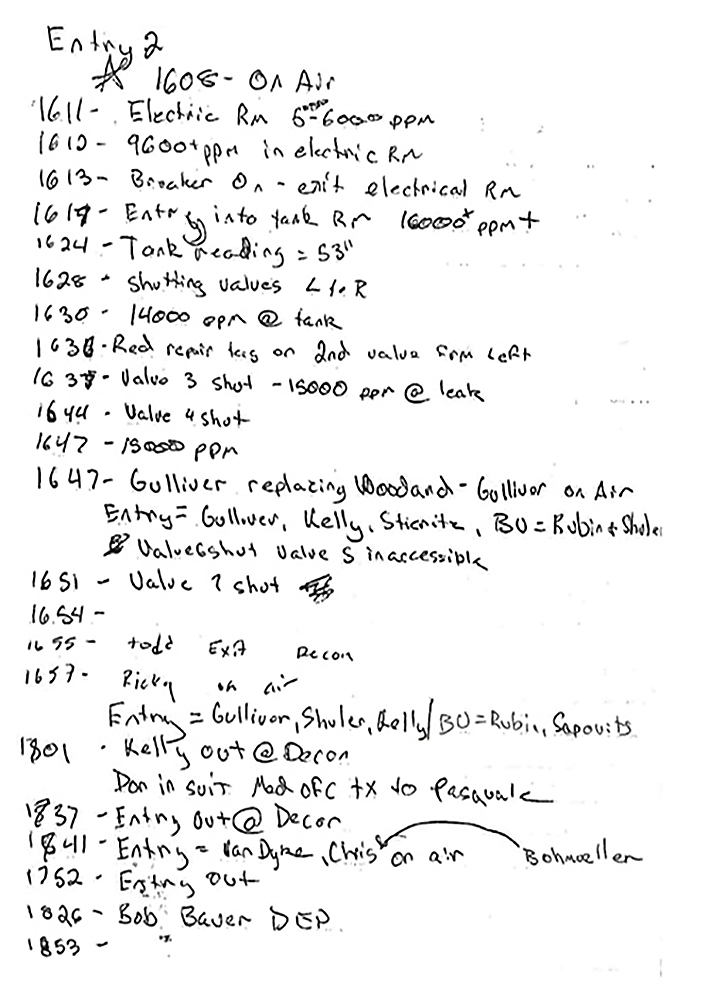
For years, we tried to create an accountability system that mirrored a fire department’s tag-based accountability system to work for the hazmat team’s operations, with subpar results. After this incident, we developed a new accountability system on a command board. When you open the command board, the bottom is based off an ICS 208 HM (Site Safety and Control Form), while the top is a versatile operational organizational chart. Rather than having a stock command board with predetermined apparatus magnets, we had magnets made featuring individual team members’ names. Now, when members arrive on scene, they tag into the command board; their corresponding magnet is moved into the “On Scene” section, which represents the hazmat team’s staffing pool. As members are assigned to operational roles, their corresponding magnet is moved into their assigned role. This allows us the versatility to expand or contract our operations as needed while reassigning members’ roles on the fly and maintaining accountability.
Listen to the facility’s product and container specialists, but trust your instincts. This lesson was vitally important, but also trust your instincts and fall back onto your training. Always verify your information. The first question hazmat leadership asked facility personnel was, “Is your ventilation system on and working?” Facility personnel replied that the system was on and operating properly. We later found out—18 hours into the incident—that this was incorrect; workers had shut the ventilation system off prior to evacuating the building. Air-monitoring results showing high concentrations of ammonia in the engine room should have triggered us to question if the ventilation system was working properly. Instead, we took the facility’s personnel at their word and assumed that we had an ammonia leak inside the building that was so large it was overcoming the ventilation system. Responders should have confirmed that the ventilation system was operating properly on the initial entry. If we encounter this situation again or if there is no ventilation system, our tactics will change by using positive-pressure ventilation to ventilate the atmosphere prior to entry and maintain that ventilation to keep concentrations down inside the building. These actions would drop ammonia concentrations within the structure and reduce threat levels to personnel.
Facility personnel also advised us that we needed to operate a hoseline inside the building to knock down vapors enough for facility personnel to operate inside the building and fix the leak. Although we knew that ammonia has an affinity for water, we did not think this would work well enough to drop levels from 15,000 ppm to levels where facility personnel could operate safely. Fortunately, Tanner Industries, a major shipper of anhydrous ammonia throughout the country, offers a two-day hands-on class on ammonia in southeast Pennsylvania. This class never discussed spraying water on ammonia, which would have led to a caustic solution of ammonium hydroxide that we also would have needed to address. Operating in chemical vapor protective clothing is already cumbersome, and we felt that spraying large volumes of water would increase the potential for an entry team member to fall, possibly resulting in a suit failure. Following a quick risk/benefit analysis coupled with leaning on our knowledge, training, and experience, we politely told the facility that it needed to go back to the drawing board and come up with a different plan.
Know the limitations of your instrumentation. Six months prior to this incident, the MCHMRT completed a year-long process of researching a suitable replacement for our multigas and specific gas meters. After careful consideration, it decided to go with new meters for gas and ammonia detection. An ammonia-specific sensor maxes out at 100 ppm. For ammonia detection, we selected a stand-alone photoionization detector because it maxes out at 15,000 ppm and can be backed up with colorimetric tubes, if needed. It is critical to fully research all instruments and their corresponding limitations. This research and knowledge will pay dividends on the incident scene.
Have firsthand knowledge of the system, valving configuration, and operation. We hit a major roadblock when all the facility personnel who had this knowledge were unable to pass preentry medical monitoring. This was most likely because these individuals were not firefighters and were somewhat nervous about us sending them into an atmosphere with 50 times greater than published IDLH values. It was mission critical that these individuals go downrange and assist with mitigation. The Bucks County Hazmat Team has a doctor who responds with it. Fortunately, we were able to lean on this doctor for information and guidance and finally clear facility and contractor personnel to pass medical requirements. Montgomery County also has a Physicians Response Team; following this incident, we added it on to Level 1 responses to bring Medical Command to the scene for medical guidance when there is a mission-critical issue. Preentry vitals are important, but being able to reach back to Medical Command for guidance when needed is a great resource to bring to the table.
Hazmat teams must train outside the norm. Make your hazmat training as realistic as possible. On this incident, we worked off six- and eight-foot A-frame ladders and operated valves above our heads while physically climbing over the leaking 22,000-pound anhydrous ammonia storage tank. Just because you train to shut valves that are at eye level while standing on the ground doesn’t mean that is where they will be on the incident scene. Locating and isolating piping valves based on facility information posed significant challenges. So, include identifying and overcoming some of the communication hurdles in locating the correct valves in training evolutions.
Consider your response matrix and make changes as needed to set yourselves up for success. Following this incident, we changed our levels of response to bring all needed resources to the scene when required. When hazmat officers upgrade the response to a Level 2, we no longer limit our staffing by bringing only a single hazmat station response. Now, when we upgrade to Level 2, it brings all available MCHMRT personnel to the scene. As stated earlier, we also added the Physicians Response Team to our response matrix to automatically dispatch that resource directly to the scene when needed.
Have knowledge of chemical and physical properties. The IDLH for ammonia is 300 ppm, while the LEL is 15 percent (or 150,000 ppm). This is why the primary hazard is a toxic inhalation hazard; it is much easier to reach 300 ppm than it is to reach 150,000 ppm. However, this does not negate the flammability hazard. When entering a smaller compartment or room, the concentration is able to climb higher faster. Action levels for flammability inside a building are 10 percent of the LEL. Hazmat team members must understand chemical and physical properties; what they mean; and, most importantly, how to measure them and convert the LEL percentages to ppm. This is critical at anhydrous ammonia incidents because the primary instrument may be a photoionization detector, which reads in ppm, not percent of the LEL. If your members don’t understand how to make the conversion, they may put themselves in an atmosphere for which their PPE is not suited.
This incident was a low-frequency/high-risk response that created challenges for emergency responders beyond those typically found with anhydrous ammonia refrigeration systems. The leak was in the absolute worst possible location, on the storage tank side of the isolation valve, meaning that the piping wasn’t leaking but the 22,000-pound anhydrous ammonia storage tank was, with no way to isolate the leak other than transferring all the product into a recovery vessel.
This multioperational-period incident created numerous operational, logistical, and medical challenges that we needed to overcome. The MCHMRT trains to operate in hazardous atmospheres and control hazardous material releases. To my knowledge, no hazmat team trains to operate an industrial cold storage refrigeration system, but this is exactly what the MCHMRT membership did. Because of their innovation, courage, and dedication, this incident was safely and successfully resolved after 22½ hours.
References
International Institute of Ammonia Refrigeration. The History of Ammonia Refrigeration. Retrieved from https://www.iiar.org/iiar/WCM/About_Ammonia_Refrigeration/The_History_of_Ammonia_Refrgeration.aspx.
Computer-Aided Management of Emergency Operations. Ammonia. Retrieved from https://cameochemicals.noaa.gov/chemical/4860.
JOHN R. WATERS II joined the fire service in early 2001 as a volunteer with the Brookline Fire Company in Haverford Township, Pennsylvania. He has a bachelor’s degree in emergency management from the University of Maryland—University College. Waters has attended hazardous materials training at the Center for Domestic Preparedness, Texas A&M University, and the National Fire Academy. He also led the Montgomery County (PA) Hazardous Materials Response Team in 2016.

